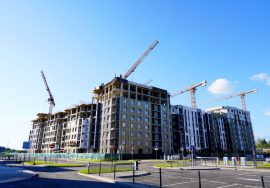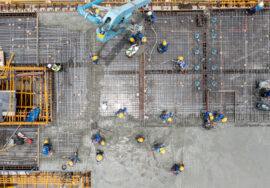
Meeting The Demand For Sustainable Housing And Green Buildings
Sustainability in the real estate context is not only limited to energy conservation but also includes the use of resources, their impact on the surrounding environment, and the living conditions of the inhabitants.
The climate change conversation in India has picked pace in the last few years. Millennials and Gen X consistently rate the environment and climate change as the two issues they worry most about. All industries and sectors have now consciously been working towards reducing the carbon footprint and even the real estate sector is doing its bit. Even governments are now giving various incentives to push eco-friendly development. To put things in perspective, buildings contribute to one-third of global greenhouse gas emissions and consume 40 percent of the world’s energy. In addition to this, the construction sector in India is responsible for about 22 percent of our total CO2 emissions.
Hence, to cope with changing as well as challenging times, it has become extremely important for us to think about sustainability in this sector. The focus needs to shift to using alternate resources and technologies which help in saving cost and resources and at the same time align in regards to the objective of having minimal impact on the environment for a balanced life.
In the post-COVID-19 world, where increased focus is being laid on overall well-being, it is said that sustainability will be the main element.
What Are Green Buildings And Why Do They Matter
The global green building movement started about two decades back. The genesis of this movement was to cut down the use of extravagant resource consumption in modern buildings. In India too, the demand for Green Buildings has increased tremendously in the last 10 years. As per estimates, India’s green building market will double by 2022 and reach 10 billion sq ft and will be valued at USD 35-50 billion.
Environmentally responsible and resource-efficient buildings are usually classified as green buildings. These buildings not only reduce or eliminate negative impacts on the environment, by using less water, energy, or natural resources, but in the long run, even have a positive impact on the environment. This is possible as they are capable of generating their own electricity, have better ways to harvest water, and even increase biodiversity.
The homebuyers of today are not just aware of these buildings but are also looking for these features for the obvious benefits that they offer. There is an increased demand for a home that has ample sunlight, proper ventilation, and access to fresh water. People are also increasingly aware of the materials that are being used in construction and the impact these have on the environment.
Benefits of Green Building
Sustainability in the real estate context is not only limited to energy conservation but also includes the use of resources, impact on the surrounding environment, and living conditions for inhabitants. Green homes can help in saving time and money as the materials used are easily accessible. In some of these buildings, developers buy the materials locally, which not only saves time but also reduces the carbon footprint by minimising the distance they need to be shipped. This helps in creating a sense of community and supporting the domestic economy.
Apart from the cost-benefit, there are many social drivers for green buildings that include improved occupant health and well-being and increased worker productivity. Given the environmental benefits and the satisfaction, it brings to the workforce green buildings are increasingly being sought after by the corporate sector.
Need for Affordable Green Buildings
It is a known fact that eco-friendly buildings help in saving operational costs by cutting down electricity, water, and other utility bills. However, it is often perceived that the cost of construction for these buildings can be higher. Green concepts and techniques in the affordable housing sector can help attain a reduction in energy and water consumption, improved health, hygiene, and sanitation; better ventilation and light in the dwellings, etc.
There are many low-cost techniques that are being deployed that help in cutting down even the cost of building. In addition, the use of recyclable products that are locally available can further help in bringing down the cost of development. Most importantly, the use of eco-friendly materials will help enhance the occupants’ quality of life.
In India, the market for affordable housing has seen a strong uptick in the last two years and that, in turn, is also fuelling the demand for green buildings.
Key Aspects That Green Building Focus On
1. WasteNothing – Avoiding wastage is one great way to cut down on the materials that are being used.
2. Adapt to the place/location/building – Every place has its own set of challenges and solutions. Solutions that work for a building in Shimla will not hold true for, say, another one in Mumbai. So, builders need to think on their feet and adapt to the environment.
3. Optimise rather than maximise – Whatever materials are available, one should try and use them in a very optimised manner rather than maximizing the number of materials.
4. Build sustainable designs that last longer – In the bid to use sustainable material one should never compromise on durability.
5. Use materials that can be reused/recycled – There are many materials that can be reused and thus help in saving cost. For example, corridor and verandah flooring can be made using waste marble, kadappah, kota, and red Agra pieces, with a simple IPS Border. This move alone can help save at least 30% cost over regular floor options. Another option could be using natural stones instead of using ready-made colours from the market. This gives a graceful look to the bare concrete structure.
6. Adopt energy-efficient measures that help in saving costs in the long run – The focus should be to adopt methods that help in lowering the cost of day-to-day living. Relying on renewable energy can help in reducing monthly bills by up to 20-30 percent.
The Big Green Push
Though at a nascent stage, India has emerged as one of the leading countries in terms of green building projects. India ranks only second after the US in terms of the number of green technology projects and built-up areas. The Indian government too has played a pivotal role in promoting green building. A significant step in this direction was taken in 2007 with the introduction of the Energy Conservation Building Code, which was launched by the Bureau of Energy Efficiency and later updated in 2017.
Additionally, several government agencies have acknowledged and incentivised green buildings, including central agencies such as the Ministry of Skill Development and the Small Industries Development Bank of India, as well as State governments and municipal bodies across India.
Indian Green Building Council (IGBC) in the past few years has been working intrinsically with several Central and State Government agencies to promote the green building movement in the country. Some of the Central and State Government agencies have given recognition to IGBCs’ Green Rating Systems. This too has helped in fuelling the trend for green building in India.
There is a huge scope for Green buildings in India. Given the advantages it offers, the incentives that the government is providing to this construction, and the growing demand by environment-conscious consumers, the future for this segment seems very bright.







